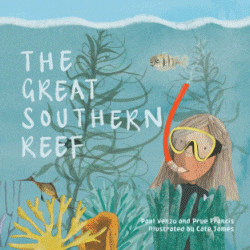
The Great Southern Reef
The Great Southern Reef
Paul Venzo & Prue Francis
Cate James
CSIRO Publishing, 2022
32pp,, hbk., RRP $A24.99
9781486315314
Most Australians, even our youngest and newest, are familiar with the Great Barrier Reef, the world’s largest coral reef system comprising more than 2,900 individual reefs and 900 islands which stretches over 2,300 kilometres along the Queensland coast, one of the seven natural wonders of the world and the only living thing on earth visible from space. But even longer and more accessible to most is the Great Southern Reef , a fringe of interconnected underwater systems that span 8000km from the NSW/Queensland border, around Tasmania and its islands, along our great southern coastline and up to Kalbarri in Western Australia.
First defined as an entity just six years ago in 2016, it has already been identified by Mission Blue as a Hope Spot, a biodiversity hotspot critical to the health of the world’s ocean environments, particularly because of its forests of giant kelp, Ecklonia radiata, that offer shelter and food for more than 4000 species of invertebrates, countless fish species such as the weedy sea dragon, the WA rock lobster and the blacktip abalone, and many seaweeds, most unique to the reef, which offer carbon storage to offset climate change as well as potential for a plastic-free world of the future.
But despite 70% of us living within 50km of it, its existence is little known and so this beautifully illustrated, informative book is an essential step in teaching our young students (and hopefully the adults in their lives) not only about its existence and inhabitants but also its importance. After a storm thrashes the coastline, Frankie and Sam join Professor Seaweed in a walk along the beach to see what has been washed up overnight. Together they find many things and not only does Professor Seaweed explain what they are but she also demonstrates the need to leave the beach as we find it, to be careful when delving into rockpools, and the significance of the saying, “Take only photographs, leave only footprints. Kill nothing but time.” However, she does encourage the children (and the reader) to collect any rubbish that will also have been washed up as their contribution to helping the beach and its creatures stay pristine and healthy.
Even for those of us who do not live within that 50km of the reef, or the ocean, it is a destination that naturally attracts millions every year, so this is the perfect book to introduce our children to the existence of the reef itself and their role in protecting it. Teachers notes linked to the Australian Curriculum are available to help you do this.
